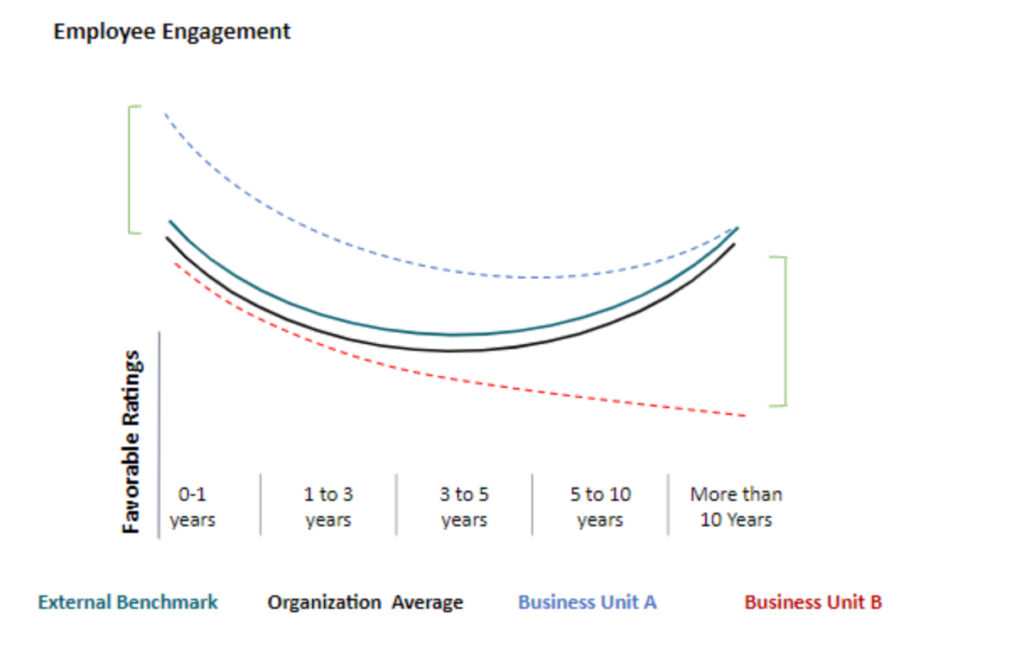How to Keep Tenured Employees Engaged in the Workplace
If you think employee engagement is all about getting new hires excited about their work, you’re accidentally ignoring one of the biggest challenges in keeping your workforce as a whole engaged. Tenured employees.
As they accumulate experience and expertise, tenured employees become key to some of your most important work. They accumulate a massive amount of institutional knowledge, allowing them to work independently and answer questions for people throughout your org chart. But as you learn to rely on them more—and the quality of their work becomes more consistent—tenured employees usually become less engaged in their work.
Why is that? And what can you do to get them excited again?
Let’s find out. Discover how employee engagement software can help keep your tenured employees engaged and happy with their work.
The importance of retaining tenured employees
Your tenured employees aren’t just some of the most important collaborators at your organization; after enough tenure, they become the organization. No matter where they’re at in the hierarchy or what their role is, they’re the ones people learn to go to with questions that aren’t answered in your employee handbook, they’ve seen projects succeed and fail over the years, and they’ve probably outlasted some of your leadership. They’re an incredible resource that money can’t buy and hiring can’t replace (at least in the short term). Smart leaders learn to rely on them extensively, too.
Additionally, your tenured employees are a strong signal that your organization is stable, reliable, and healthy. That’s important for attracting potential investors, reassuring new talent that they’re joining an organization that’ll take care of them, and maintaining high morale.
If an organization takes its tenured employees for granted, it will learn to see their impact in their absence. The team they were a part of will realize just how many of their tasks relied on this person. Project managers will need to rework their plans around this new absence. Leaders will lose a subject matter expert they had learned to rely on. The level of institutional knowledge at your workplace will take a significant hit and the people who are left will have to find ways to patch any gaps in that knowledge. A new hire might be able to fill in for the skills you lost—at a significant cost—but they won’t have that level of institutional knowledge until their own tenure matches that of the person who left.
Retaining tenured employees is essential for morale and your organization’s growth, but it’s far from simple. There are unique challenges that come with engaging tenured employees that make it an entirely different process to engaging and retaining new hires.
The challenges of keeping long-tenured employees engaged
Before covering these challenges, there’s an important element to the relationship between employee tenure and engagement to explore. While “tenured” sounds like a single category, employees who’ve been at your organization for longer actually go through a few ups and downs in engagement over their time with you. This is what’s referred to as the tenure curve.

Note how high employee engagement starts in an employee’s first year. Then see how it trends downward after that first year, bottoming out at three to five years before starting to rise again after five years? You’ll run into unique employee engagement challenges at each point of that curve.
Let’s cover these now.
Employee engagement challenges at less than a year of tenure
While your newest employees are usually your most engaged employees, there are still challenges involved in getting them there.
- It takes significant resources: Most organizations put the majority of their employee engagement resources into getting new hires engaged and maintaining that engagement. That means there’s a lot more pressure to see a significant return on your investment (ROI) in these early stages.
- The barrier to leaving is at its lowest: According to the Work Institute’s 2020 Retention Report, almost 40% of people who leave their jobs do it in the first year. Of this group, two-thirds leave in the first six months. That makes employee engagement a high-stakes game at this level of tenure.
- Organizational fit isn’t guaranteed: Even the most robust hiring process doesn’t guarantee that a new employee will be a good fit for your organization. Any time a potential misalignment becomes obvious, expect a new employee to feel less engaged with their work.
Employee engagement challenges at one to three years
When someone’s been with your organization for more than a year, the honeymoon period is officially over. The job loses its initial luster and they settle into the realities of their role. That comes with its challenges.
- Employee engagement takes a nosedive: While your employee engagement resources are focused on getting new employees settled in and ready to work, those who aren’t quite part of the new crowd anymore get less and less engaged.
- Learning opportunities decrease: New employees have tons of learning opportunities made available to them. They’re learning how to work with their team, how their skills can best benefit the organization, and how other teams work. As soon as they hit a year of tenure, they’re expected to work more independently and get fewer opportunities to learn new things or collaborate on new tasks.
- “Do they really care?”: When an employee is still completing their first year, they get a ton of attention. Everyone’s lining up to meet them, make them feel welcome, and give them all the resources they need to succeed. Then, as soon as they’re not “new” anymore, all that attention stops. They’re just another person on the team now. For some, that sudden drop in attention can have a serious impact on how engaged they feel. They might even start to wonder if the organization really cares about them.
Employee engagement challenges at three to five years
Once an employee hits this level of tenure, they’re fully settled in their role. People can rely on them consistently, they’ve contributed to important projects, and they know their way around the block. Yet employee engagement tends to hit its lowest point at this level of tenure. Why’s that?
- Same old same old: The routine an employee learns to establish in their first year at a new job becomes ironclad (and repetitive). There isn’t the excitement of learning a new role or dealing with new challenges. For some, that can lead to serious boredom and frustration, and they might think it’s a problem with the organization rather than an inherent part of their development as an employee.
- Plateau in development: Maybe they’ve already had a promotion, maybe they haven’t. Either way, employees at this level of tenure often feel like there isn’t a lot of room for career growth at your organization. They might not have the experience they need to reach managerial or leadership positions, or they might have hit the end of the individual contributor track they’re on. For more ambitious employees, this feeling of hitting a dead-end can be a total dealbreaker, tanking their engagement.
- More exposure to office politics: Having been at your organization for a while, this employee knows how the sausage is made. Which projects get buy-in (and which ones don’t), who gets promoted, and how they can get ahead in their work are all examples of tenuous issues they’ll have been exposed to. They’ll know exactly how your organization handles these things, and the things they find can seriously impact their engagement.
- Baggage: If your organization can consistently treat all employees well, this might be less of an issue. But in many workplaces, there can be the occasional miscommunication, misunderstanding, or slip-up. At three to five years of tenure, these can start to accumulate, meaning that employee is carrying baggage in every interaction with anyone in your organization. That can make even the most mundane situations more frustrating.
- Prime for poaching: At three to five years of tenure, your employees start to look a lot more attractive to competitors. They have a significant amount of experience without being so invested in your organization that they wouldn’t consider jumping to another company. In hot labor markets, employees with this amount of tenure might get messages from recruiters multiple times a week.
Employee engagement challenges at five to 10 years
At this stage of their tenure, employees have often been around longer than their managers. They might have seen entire teams turn over, and they’ve been through some of the organization’s rockstar wins and terrible lows. Here’s where they might struggle to feel engaged.
- Clear goals and accountability matter most: While a newer employee might have the flexibility to adjust to evolving goals and responsibilities, someone who’s been with you for at least five years cares about stability. They’ll also be the most likely to see their engagement dip if they watch people get away with the sort of thing they’d have been reprimanded for.
- Potential career changes ahead: An employee at this level of tenure isn’t just looking for a promotion. They’re usually looking for a significant change. That might mean looking wistfully at leadership roles on your org chart or even considering lateral moves to completely different industries. When you’re looking at improving engagement for these employees, you’re not just trying to keep them from jumping to a competitor. Big life changes are on the table and you need to account for that.
- Lack of recognition: When someone’s been with your organization for over five years, it’s easy to take them for granted. They do great work, but they’ve always done great work. They’re supportive of their colleagues, but they’re expected to be. For some employees, watching newer employees get all the kudos can be grating after a while.
Employee engagement challenges at over 10 years of tenure
Employees with more than 10 years of tenure who aren’t founders might as well be. They’ve contributed so much to the organization that their influence can be felt everywhere. That feeling of accomplishment, amassed over a long career with your team, means these employees are some of the most engaged, rivaled only by the new arrivals. That being said, there are some ways that engagement can be impacted.
- A potential eye on retirement: Not all employees who’ve accumulated this much tenure are nearing retirement age, but many will be. It can be tough to feel passionate about the work you’re doing when you’re daydreaming about taking an RV on that cross-country trip you’ve always wanted to do.
- Life changes: Anyone who’s with your company for any length of time will go through life changes during their tenure. But those who’ve been with you for a decade or more are likely to hit more along the way. This might lead to them being more distracted, being less available, or even burning out.
- Career jumps: Accumulate 10 years of experience in any field, and you’re on track to start hitting those big leadership positions. While some at this stage have an eye on retirement, others are looking for those cushy executive jobs. If one isn’t available at your company, these employees might start looking elsewhere.
If you’re responsible for your company’s employee engagement strategy, you have tons of challenges to deal with. But it’s not hopeless. There’s a lot you can do.
How to manage tenured employees
While the employee engagement challenges you’re facing will vary based on a specific employee’s level of tenure, the solutions are pretty standard across all categories—except perhaps with your newest employees. For employees who have been with your organization for at least a year, here are the best ways to keep them engaged throughout their tenure.
Make their voices count
New employees bring fresh eyes that can help leaders re-evaluate how they’ve always done things. However, a newcomer might feel nervous about sharing their opinions, which prompts leaders and managers to encourage them to speak their minds. That effort should apply to every point in that employee’s tenure. People who have years of institutional knowledge have a lot to share but often don’t feel heard in the way newer employees are.
Keep development opportunities available
After their first year or two, employees start seeing promotions and opportunities for advancement pop up. Organizations have invested significant time and resources into getting them in the door, and they’ll use those opportunities to keep newer employees engaged. But once they’re past year two, many employees feel they don’t have these same opportunities. Some want to keep advancing in their current career track while others might be looking at lateral moves. Unless your hands are completely tied, you should work with people to find the opportunities that motivate them most and make them achievable.
Recognize success at all points of their career
It’s too easy to take the success of more tenured employees for granted. That’s why you should go out of your way to recognize them. Feeling a lack of recognition tends to affect employee engagement more between years one and five, when the memories of being the new kid on the block are most fresh. Having a system in place to recognize success across all levels of tenure—and even encouraging employees to recognize each other—can do wonders here.
Always challenge them
When employees settle into their roles, their skill level might start to outpace the complexity of the tasks in front of them. If they don’t feel challenged, they’re more likely to just go through the motions until something better comes along. That’s where you need to find new ways to challenge them. You’re not looking to make their work arbitrarily difficult; you just want to encourage them to push their limits and seek out challenges just outside their comfort zone.
Make feedback the default
Your employees are hungry for feedback. They want to know where they’re doing great, where they need to improve, and how they should forge ahead towards better things. Ensure that even tenured employees get more one-on-one time with their managers, so they can feel like their development is being supported no matter how long they’ve been working with you.
Keep goals aligned
One of the most frustrating things for tenured employees is knowing they’re doing a great job at a certain task only to find out it isn’t contributing to the overall organization at all. With highly skilled, tenured employees, you want to put extra effort into keeping their goals aligned with the organization’s. Feeling like they’re moving the needle will keep them motivated throughout their time with you.
Get engaged
Maintaining employee engagement throughout an entire career can be tough, and there will be natural ups and downs over someone’s tenure. However, the challenges faced by a disengaged newcomer are very different from those of a disgruntled veteran, and HR teams need to be aware of this. Remember that as long as you keep the communication channels open, keep challenging people, and recognize their work, you can have rockstar teams who are passionate about their work no matter how long they’ve been with you.




